From the first observation of 2019, a Barred Owl sitting on a deck submitted by naturalist extraordinaire Roy Pilcher, to a Christmas Fern laying on snow shared by Bondaley on the last day of the year, naturalists added over 100,000 biodiversity records to our rapidly growing database of life in Vermont.
And amazing observations kept coming all year long. We had 3,896 naturalists contribute more than 104,140 observations representing over 3,300 species verified. Over 2,800 naturalist helped to identify and verify data. And we joined the more than 615,000 iNaturalists worldwide that submitted over 13 million observations in 2019!
Check out the 2019 year in review statistics dashboard, and if you’re an iNaturalist you can see your year in review too. Share it proudly on social media and tag it with #vtatlasoflife!
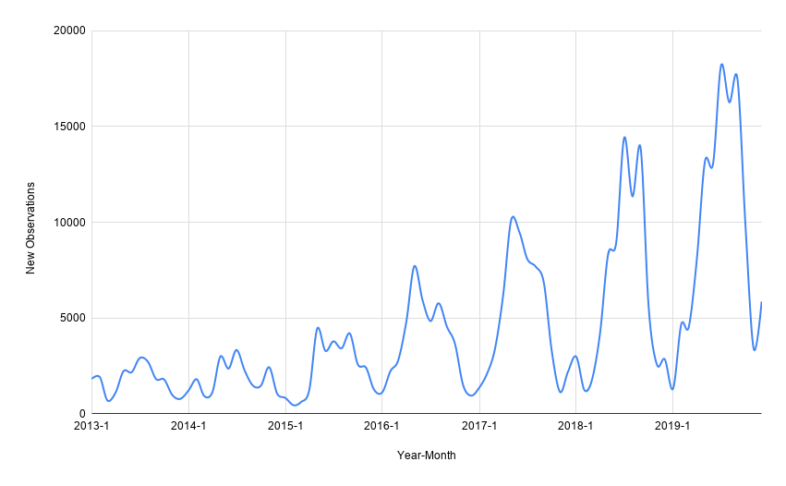
The Vermont Atlas of Life on iNaturalist has grown leaps and bounds since 2013. We now have over 375,000 biodiversity observations in the database. Note the peaks and valleys of data sharing match the seasons each year.
Research Grade Observations
An observation submitted to iNaturalist becomes what is called ‘research grade’ when it has: a date, latitude and longitude coordinates, photos or sounds, and the community agrees on the identification to species level. We have nearly 250,000 research grade observations comprising over 5,000 species in the Vermont Atlas of Life iNaturalist database. These data are shared continually with the Global Biodiversity Information Facility, an international open data infrastructure that allows anyone, anywhere to access data about all types of life on Earth, shared across national boundaries via the Internet.
It takes a village for an observation to become research grade. Other naturalists that can identify species from the submitted images or sound recordings help make these observations into research grade data. We had over 5,000 iNaturalists help identify observations. The top 10 in 2019 verified nearly 50 % of all the verifiable records in 2019. Thank you to everyone that helped identify observations!
| Rank | User | Identifications |
|---|---|---|
| 1 | cgbb2004 | 12,078 |
| 2 | tsn | 9,248 |
| 3 | nsharp | 6,145 |
| 4 | bryanpfeiffer | 4,827 |
| 5 | joannerusso | 4,267 |
| 6 | charlie | 2,613 |
| 7 | celestihel | 2,536 |
| 8 | maxallen | 2,405 |
| 9 | beeboy | 2,222 |
| 10 | blustm | 1,712 |
Some New and Amazing Discoveries in 2019
Fly Species New for Vermont Discovered by iNaturalist
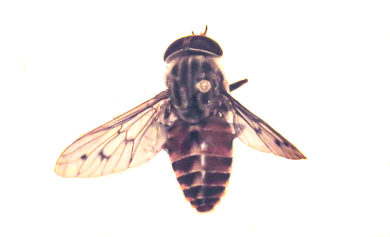 You don’t have to go far to help the Vermont Atlas of Life discover species new to Vermont. You just have to be observant. On August 12th Roy Pilcher, citizen scientist extraordinaire and recipient of the Julie Nicholson Citizen Science Award in 2009, found one in his car!
You don’t have to go far to help the Vermont Atlas of Life discover species new to Vermont. You just have to be observant. On August 12th Roy Pilcher, citizen scientist extraordinaire and recipient of the Julie Nicholson Citizen Science Award in 2009, found one in his car!
Roy was visiting the Helen W. Buckner Memorial Natural Area when he noticed that a large fly had flown through his open car window. Luckily, Roy is friends with Dr. Jeff Freeman, Professor Emeritus at Castleton University. Jeff has devoted much of his research into horse and deer flies and his extensive collections are housed at the University of Vermont Natural History Museum, Rutgers University, Natural History Museum in Philadelphia and other museums. Curious as to its identity, Roy captured the fly and delivered it to Jeff for an identification. The fly was Tabanus limbatinevris, a new species for Vermont!
Lacking a common name, Tabanus limbatinevris was first described in 1847, but remained unrecognized until 1983 because it was confused with other similar horse flies. Its range was thought to be from Michigan and Ontario east to New Hampshire, and south to Georgia and Texas, but it had never been found in Vermont before Roy’s fortunate discovery.
Roy, a dedicated user of the Vermont Atlas of Life on iNaturalist added his observation and Jeff’s identification to the project. The specimen will join others in the UVM Natural History Museum collection. There are now 14 species of horseflies known from Vermont.
Introduced Jumping Spider Spotted in Vermont for First Time
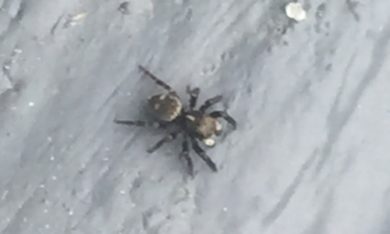 On June 10th Jasper Barnes, a wildlife biology student at the University of Vermont, snapped a photo of a tiny jumping spider near campus and shared it to the Vermont Atlas of Life on iNaturalist. He knew it was a jumping spider, but he wasn’t quite sure what species it was. It wasn’t long before a few experts saw his record and identified it as a Black-palped Jumping Spider (Pseudeuophrys erratica), an introduced species native to Europe and Asia. This is the first record for Vermont and the northernmost in the United States.
On June 10th Jasper Barnes, a wildlife biology student at the University of Vermont, snapped a photo of a tiny jumping spider near campus and shared it to the Vermont Atlas of Life on iNaturalist. He knew it was a jumping spider, but he wasn’t quite sure what species it was. It wasn’t long before a few experts saw his record and identified it as a Black-palped Jumping Spider (Pseudeuophrys erratica), an introduced species native to Europe and Asia. This is the first record for Vermont and the northernmost in the United States.
It was first reported in North America in New Jersey in 1982, but recent records, including this one, suggest that this species may now be established on both coasts of the United States, according to a recent publication detailing this sighting, as well as others.
iNaturalists Discover More New Moths for Vermont

Moths discovered and rediscovered. Melonworm Moth, Hermit Sphinx, and Clouded Underwing (let to right).
The Vermont Atlas of Life, with the aid of many volunteers across Vermont, has been mapping moth distribution and phenology one photo-observation at a time. Since 2013, over 1,500 biologists and naturalists have contributed more than 53,000 moth photo-observations to the Vermont Atlas of Life on iNaturalist. Together, we’ve discovered over 100 new species for Vermont, and just recently, iNaturalists have done it again when two species new to Vermont were discovered and one species that was only known from a historical record was rediscovered.
On September 23rd, moth expert JoAnne Russo photographed a Clouded Underwing (Catocala nebulosa) in Rockingham and shared it on iNaturalist. Most records for this species range farther west and south of Vermont. The larvae feed on Bitternut Hickory (Carya cordiformis), which is found in the major valleys of Vermont and Eastern Black Walnut (Juglans nigra), found in scattered locations in the state.
The next day, iNaturalist Lewis Holmes photographed and shared a Melonworm Moth (Diaphania hyalinata) in Middlebury, another first for Vermont. This moth is also known from farther west and south (although there is one record from Quebec just north of the Vermont border), ranging into South America. In the north, adults fly from September to November. The larvae feed on cucumber, melon and squash. They construct a loose silken structure under the leaves.
And then a long lost moth was rediscovered. In August Susan Elliott, found an adult Hermit Sphinx Moth (Lintneria eremitus) near Rutland and posted it to the Vermont Atlas of Life on iNaturalist. It hadn’t been reported in Vermont since the 1990s. Then, on October 2, iNaturalist Lisa Maggio posted an image of a caterpillar in Manchester Center on iNaturalist. Although she didn’t know what it was, it was quickly recognized as a Hermit Sphinx Moth by others. It was found on Monarda, one of their host plants that they feed upon. But it turns out, among the more than 350,000 observations submitted to the Vermont Atlas of Life on iNaturalist (and counting!), the Hermit Sphinx Moth was rediscovered two years ago! Roy Pilcher had submitted a photo-observation of a caterpillar in 2017 from West Haven. We’d somehow missed it in the ever-growing database. The good news is that it appears that the Hermit Sphinx Moth, a conservation concern species throughout the region, is back on the map!
Many of us turn on special lights in our backyards on summer nights to find hundreds of moths and other insects gathering on white sheets, hunt fields and forest for day-flying moths, and place rotten fruit bait out to attract other moths. Many of these moths can be identified from good photographs (although some are impossible without dissection and examination under a microscope). With today’s amazing digital photography technology, coupled with the newer Peterson’s Field Guide to Northeastern Moths and web sites like iNaturalist, BugGuide, Moth Photographers Group, or Moths of Eastern North America Facebook Group, moth watching (aka mothing) has become increasingly popular.
Two amazing naturalists, Laura Gaudette and JoAnne Russo, have become moth fanatics and experts over the years and have been leading the charge here in Vermont in documenting moths and encouraging others. Earlier this year, they created a collection project that automatically gathers and presents all Vermont moth data from iNaturalist in one easy place – Vermont Moths on iNaturalist. If you put a moth record in the Vermont Atlas of Life project on iNaturalist, or anywhere in iNaturalist – Vermont Moths will tally it.
Record Year for Monarchs in Vermont
By all accounts, it was an amazing year for Monarch productivity in Vermont and iNaturalists helped to document this banner year. After a dismal winter count in Mexico in 2014, during the summer of 2015 we had just 48 observations reported. In 2019 we had 921 observations and it appears that other areas also experienced a good season. We’re hopeful that that winter count this year will show the population growing in eastern North America.
Over 3,500 verifiable butterfly observations representing 84 species were shared with the Vermont Atlas of Life on iNaturalist in 2019.
Plants Rule!
Plants clearly comprise the bulk of observations on the Vermont Atlas of Life at iNaturalist and 2019 was no exception. We had nearly 2,600 iNaturalists contribute over 42,000 verifiable observations comprising 991 verified species of plants in 2019! There were 162 introduced species reported and over 80 species of conservation concern.
Charlie Hohn contributed the most with 4,971 verifiable observations, and he also had the most species with 603. Helping to verify records is another important part of the data. Charlotte Bill identified 8,918 plant records, followed by Tom Norton with 7,858 and Charlie Hohn with 2,505 identifications. Remarkable work!
Explore the 2019 Photo-Observation of the Month Winners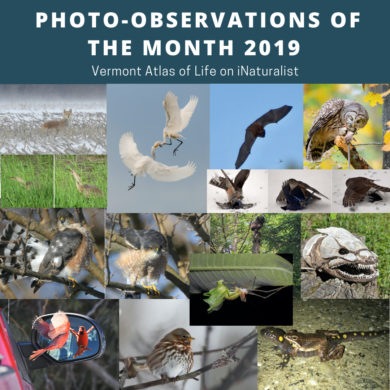
Each month, iNaturalists ‘fav’ any observation they like as a vote for the iNaturalist Vermont photo-observation of the month. Check out these awesome winners from 2019 and learn a little bit about the natural history of each organism.
We hope you’ll join the project and help us make this biodiversity database grow. Make the Vermont Atlas of Life at iNaturalist your New Year’s resolution in 2020!
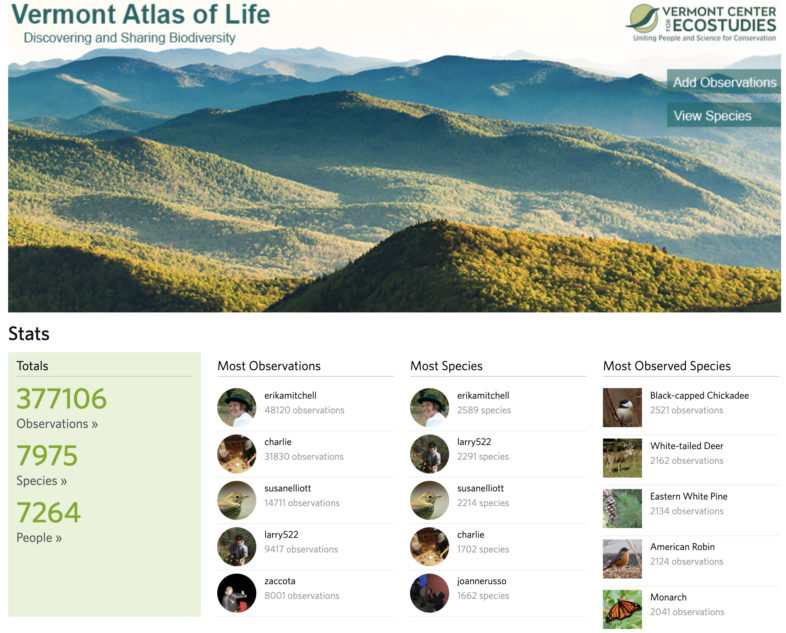
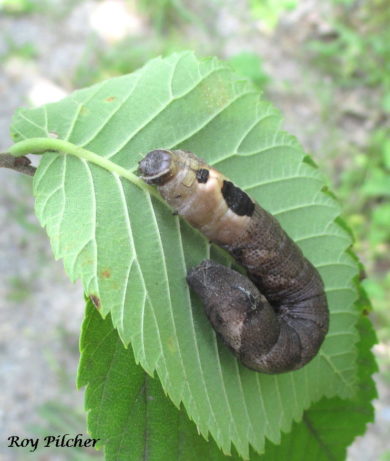
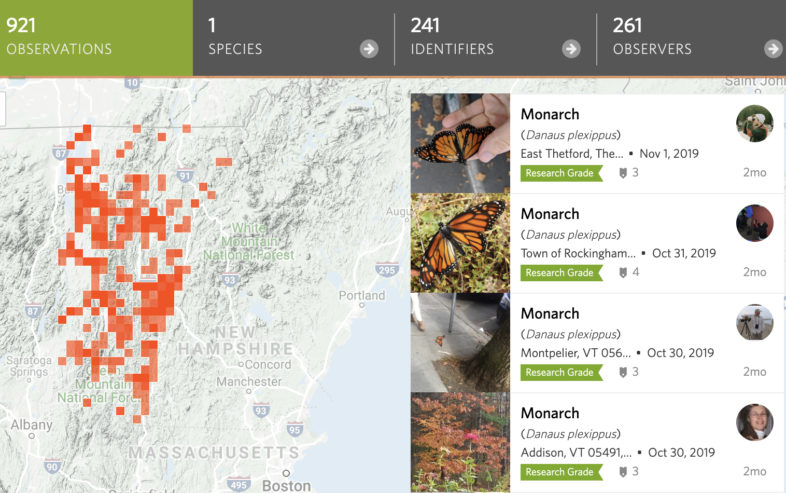
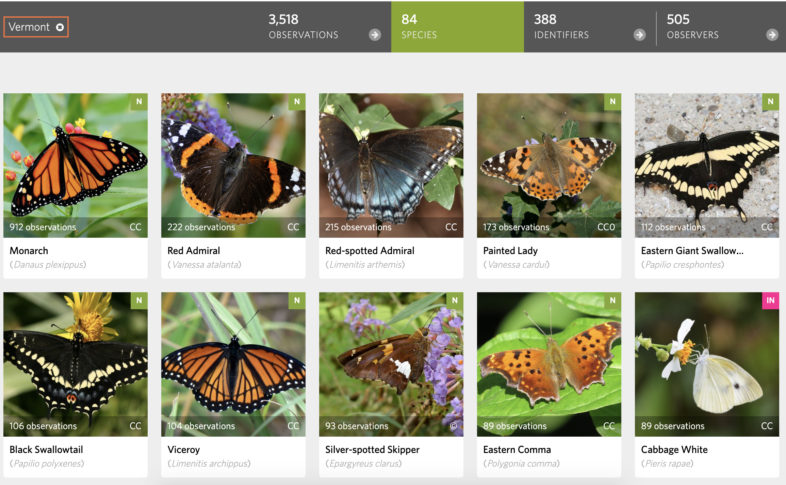
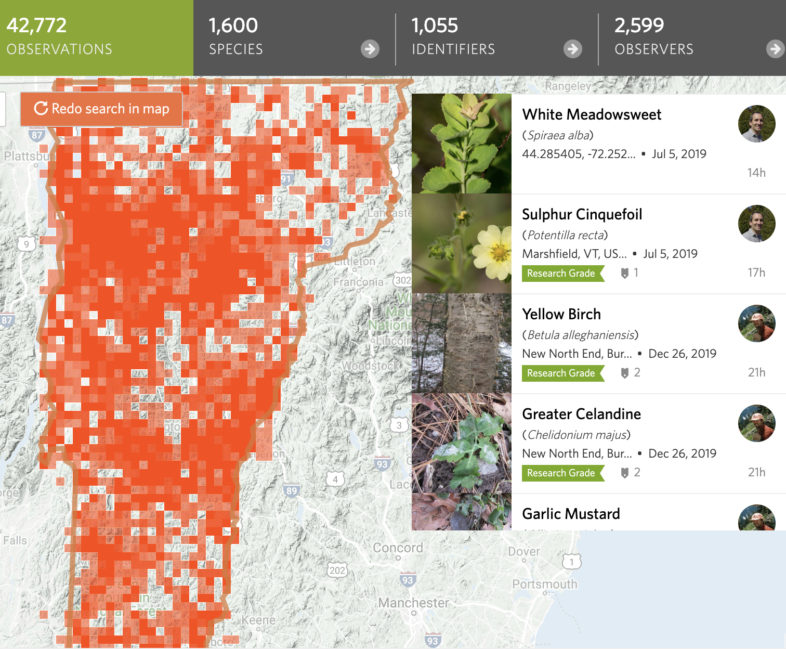

Nice…………